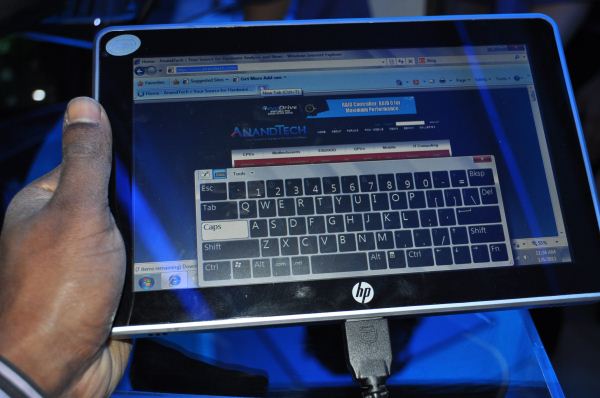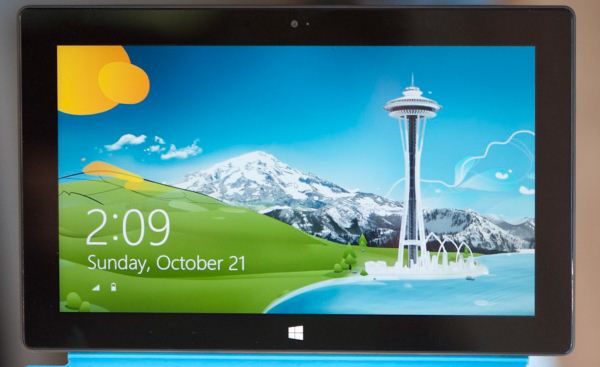The Windows RT Review
by Vivek Gowri & Anand Lal Shimpi on October 25, 2012 12:00 PM EST- Posted in
- Windows RT
- Operating Systems
- Microsoft
- Mobile
- Windows 8
- Tablets
Meet Windows RT
Microsoft’s first serious foray into tablets came just after the turn of the new millenium, with Bill Gates demonstrating the first tablet PC prototype onstage at Comdex in the autumn of 2000. From there, OEMs started releasing tablets based on Windows XP Tablet PC Edition in 2002, with a full range of pen-enabled slates and convertibles releasing over the next few years. In addition to oftentimes prohibitive cost, each had its own set of drawbacks. Convertibles tended to be quite bulky compared to their notebook counterparts (the ThinkPad X-series being a notable exception), while slates were rather difficult to use - a symptom of shoehorning a desktop operating system into a purely touch-centric form factor.
Fast forward a decade, to the beginning of 2010. After a number of conceptual non-starters in the tablet PC space - building tablet PC support into all editions of Windows Vista and 7 (other than Basic/Home Starter), the entire Origami class of devices - Microsoft’s touchscreen devices were floundering. The iPad had been announced to mixed reaction but an extremely high level of anticipation. Microsoft and HP countered with the Slate 500, an Atom-based device shown off at CES 2010 with solid state storage and Windows 7 in roughly the same form factor as Apple’s iPhone OS-based ARM tablet. With speculation pointing to a pricetag of just $549, the Slate appeared to be the most viable hope Microsoft had in trying to make mainstream headway with the tablet PC concept. But shortly after the iPad shipped in April 2010, rumors of the Slate’s demise started to circulate, and after a six month delay, the Slate 500 started shipping as an enterprise-only product in December of that year for $799. HP’s acquisition of Palm (RIP) definitely played a role in the sidelining of the Slate, but more importantly, it essentially spelled the end for the tablet PC. This was news that was perhaps known already, but the Slate saga officially pulled the plug on Microsoft’s original idea of what a tablet was.
The problem was two parts software, one part hardware. Microsoft had developed a very interesting touch-oriented user interface for its handhelds, so at least one part of the equation was relatively straightforward. The hardware issue came down to this: the iOS and Android tablets succeeding in the market ran off ARM system-on-chips, which resulted in slim, power-efficient tablets that had idle times stretching for days. At the time, there was just nothing in terms of x86 hardware that could compete with that in low-power device realm (Clover Trail and Haswell, of course, change this part of the story considerably). The other question? How to converge the touch-centric UI with the classic desktop environment that had been the corner of Windows dating all the way back to 95.
Meet Windows RT. It’s Microsoft’s first major foray into the modern tablet market, the shipping version of Windows-on-ARM, and it’s one of Microsoft’s most important product launches ever. Windows 8 shares the same touch-friendly user interface, but the ARM silicon makes RT an almost entirely tablet-centric operating system, the first for Microsoft. Combined with the focus on premium hardware experiences, this is Redmond’s most serious push to be competitive with the iOS and Androids of the world. How does it fare? Keep reading.












233 Comments
View All Comments
Dorek - Friday, November 2, 2012 - link
AFAIK, task manager tray doesn't even have thumbnails. Come on, it's not comparable to what Windows 8 and Windows RT do. Have you used them?yyrkoon - Sunday, October 28, 2012 - link
The software issue, will not be much of an issue at all.Microsoft will just write another abstraction layer ( HAL ) for ARM. Which is most likely what they've done here.
Passed that. IF any abstraction layers need to be written for the COM model, or .NET libraries. You can rest assured Microsoft will cover that as well. If it hasnt been covered already. Which Im betting it has.
Again, this is nothing like WinCE.This is a real OS, for real end users, with a different HAL.
The biggest issue as I've stated in previous posts. Is not whether it will be easy to write applications for Windows RT. But whether software developers deem it prudent to spend thousands of dollars on Microsoft development tools( not absolutely necessary ). THEN pay Microsoft a forced 30% distribution fee. Through their app store.
For me personally. The 30% fee alone is enough for me to jump ship. And I really enjoy writing apps for Windows. We'll see how it all works out in the end.
karocage - Friday, October 26, 2012 - link
This comment from the article seemed odd to me:"This isn’t like Windows Phone, where we need to see whether the platform will get any market traction before predicting the growth of the app marketplace."
Market traction and app store growth don't seem to have much if any relationship with Windows Phone. WP7 hit 100,000 apps faster than either iOS or Android and has over 125,000 now. If anything, that would seem to indicate that MS really does have a lot of pull with developers independently of market share. So while I agree that the sheer number of devices will be a big draw, I'd argue that's just the cherry on top that guarantees we're going to see a ton of support really quickly for RT/Metro apps.
Obviously buying a WinRT tablet today will be pretty limiting in terms of 3rd party software, but experience from WP7 suggests this will be a very short-lived downside of the platform.
Dorek - Friday, November 2, 2012 - link
Good point. I've been on Windows Phone 7.5 for a year, and have never had the problem of not being able to find an app I want. (With the exception of Pandora, the assholes. Can't even use third-party ones because they block them. But I have a Zune--I mean, Xbox Music Pass anyway. So screw Pandora.)andypost - Friday, October 26, 2012 - link
Anandtech writes the best articles. period.Thanks to Vivek Gowri and Anand Lal Shimpi for a great article.
Visual - Friday, October 26, 2012 - link
You say it is impossible to make desktop apps, but...I read that Win RT still has PowerShell. A lot of PowerShell scripts on x86 just invoke various functions in third-party ActiveX controls, which are just x86 executable binary libraries, and that will not work on RT... but maybe at least the core MS objects still work? For example, if Windows Forms or Windows Presentation Foundation still works, then PowerShell scripts can create desktop windows with various GUI elements.
And since there is an IE, maybe HTA applications work as well?
Do you have some scripting geek working at AT that could test these theories out?
On another topic, I am very surprised you say there are x86 executables on your install. That is just wasted space on a device that doesn't get a large drive to begin with anyway. MS would get in serious trouble if it were true... Are you sure?
And lastly, I am curious if a Win RT device is supposed to be able to get plugged to a "real" Windows computer over USB for charging or for as a mass storage drive, for transfering files... If it is, then coudn't you also plug one RT device to another RT device? Then which one will become the "host", and which one will become the peripheral?
Dorek - Friday, November 2, 2012 - link
"And lastly, I am curious if a Win RT device is supposed to be able to get plugged to a "real" Windows computer over USB for charging or for as a mass storage drive, for transfering files... If it is, then coudn't you also plug one RT device to another RT device? Then which one will become the "host", and which one will become the peripheral?"Dude...that's deep.
(That's actually a really good question. Surface can't be charged over USB, but I don't know about other ARM devices.)
tommo123 - Friday, October 26, 2012 - link
i mean if someone writes an app and gives it away. there's no sideloading so if has to go through the store right?will microsoft host it for free? if not then they're effectively killing off free software for windows are they not? at least win rt which is eventually (how they'd like) desktop windows to go too.
tipoo - Friday, October 26, 2012 - link
Yes they'll host it for free. And there are many free apps already, there was a influx of apps on launch day and most reviews were done before that. They only take a percentage of the cuts from paid apps, nothing from free.Visual - Friday, October 26, 2012 - link
I forgot one question in my previous post.How is the browser performance with many many tabs open at once? Like 20, or even 100?
I sometimes use tabs in a bit weird way, ctrl+clicking possibly interesting links in some large index page to open them in a background tab for later reviewing it in more detail. Even without Flash, with IE9 starting a new process for each tab by default and a few animated gif ads and various JS scripts on each tab, it really kills Atom Netbooks and even CULV Core 2. It's probably more of a memory usage thing than a CPU thing actually... But anyway, how could that go on these new ARM devices?